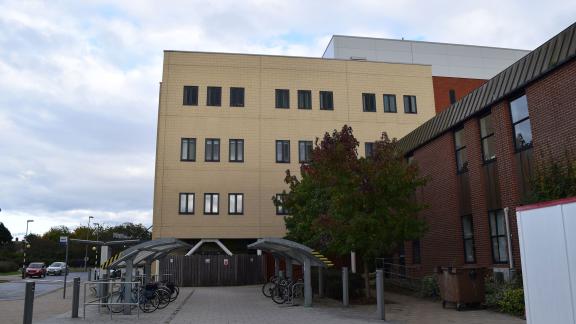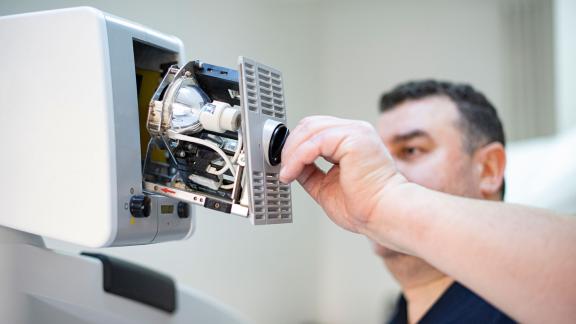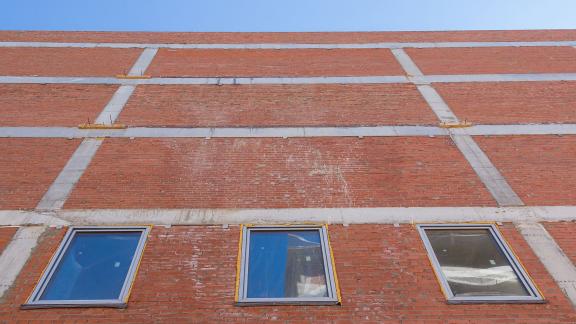NHS capital budgets must nearly double to ensure crumbling buildings and infrastructure are fit for 21st century patient care

- New report finds that NHS capital budgets need to nearly double from £7.7bn to £14.1bn – an extra £6.4bn – if the NHS is to clear the building repairs backlog and overhaul the estate to enable greater productivity and faster patient care.
- Capital funding drives productivity but the NHS has lagged behind other countries in terms of capital investment for more than five decades. The NHS now has the sixth lowest number of CT and MRI scanners per million people of the OECD countries.
- NHS leaders have said that increasing capital funding is their top financial priority ahead of the next election, alongside reform of how the capital regime operates.
The NHS won't be able to deliver faster and more productive patient care unless capital budgets are nearly doubled to at least £14.1 billion, according to a new analysis published today.
NHS leaders say the next government must boost capital funding by an extra £6.4bn in all three years of the next Spending Review to help the NHS address its £10.2 billion maintenance backlog, refurbish dilapidated buildingsupgrade equipment and turbocharge staff productivity. That would take annual NHS capital spending to £14.1 billion per year, compared to the current level of £7.7 billion. The consequence otherwise will be long waiting lists and delayed care for patients.
Local NHS leaders have told the NHS Confederation that investment in capital spending is their priority for any additional spending on the NHS after the next general election, and that underinvestment has been the number one issue holding back their progress towards greater productivity.
New analysis from the NHS Confederation sets out the impact that low levels of capital investment have had over the last decade, including the effect on productivity, and makes the case for greater funding if the NHS is to meet stretching productivity targets of 2 per cent by 2030.
Yet capital budgets continue to be raided, with the latest raid being used to plug the rising deficits in the day-to-day NHS budget caused by strike action and other cost pressures. This was outlined in NHS England’s letter to NHS chief executives on 8 November, following the outcome of negotiations between the Treasury and Department of Health and Social Care ahead of the Autumn Statement.
Matthew Taylor, chief executive of the NHS Confederation said: “Some of our members have parts of their estate that are barely fit for the 19th century, let alone the 21st, so any future Secretary of State for Health and Social Care must make the physical and digital condition of the NHS a priority, if the health service is to reduce backlogs and get productivity levels to where the government want them to be.
“Lack of capital across different care settings, covering digital and physical infrastructure and mental and physical health, is clearly not just leading to missed opportunities to improve productivity, but actively undermining it and causing patient safety issues. Health leaders across England have endless ideas about how capital funding could drive large productivity increases.
“Equipping staff with the right tools, and allowing them to operate in safe, modern, optimised environments will improve efficiency, meaning that an increase to the capital budget will help limit the need for growth in revenue spend, relieve pressure on wider NHS finances and services, and put the NHS on the path to longer-term financial sustainability.
“This will require a significant increase to the NHS capital budget to make up for years of under-resourcing and repeated raids on capital that has left much of the estate broken. Based on the assessment of health leaders, this will need to be an increase of £6.4bn to take the capital budget to £14.1bn for each year of the next spending review in order to fully address the repairs backlog and realise some of the innovative transformation projects which have previously fallen by the wayside. The next government must grasp the nettle.”
The report, ‘Investing to save: The capital requirement for a more sustainable NHS in England’, looks at where the NHS is using capital investment to drive productivity, and makes the case for greater funding if the NHS is to meet stretching productivity targets of 2 per cent by 2030.
The report also outlines examples of capital projects which have been transformational for patient care and productivity, along with numerous case studies of proposed cost-effective, forward-thinking developments which have been delayed, hindered or scrapped due to the lack of initial funding needed to get them off the ground.
Case Study: Electronic Bed Management at Maidstone and Tunbridge Wells NHS Trust
Investment in a digital bed management system has resulted in an 86% reduction in A&E bed allocation time, reduced discharge delays, released 2,300 hours of ward staff time each month and is saving them £2.7m a year. Beds in the hospital and community are coordinated centrally, enabling the Trust to re-direct incoming ambulances between hospitals to minimise handover delays and waiting times.
Case Study: Preventing hospital admissions in Bedfordshire, Luton and Milton Keynes through community diagnostics in deprived areas
Bedfordshire, Luton and Milton Keynes health system has had to scrap plans for a £25m community diagnostics centre due to lack of capital. The diagnostic centre could provide 64,554 additional diagnostic appointments per annum, releasing benefits equivalent to £27.6m through factors such as reduced length of stay, early cancer detection and reducing outsourcing costs. The absence of the centre is likely to lead to increase pressure on the local acute hospital and mean more patients have to wait longer for crucial diagnoses.
Leaders across the country have many ideas to transform care and increase productivity should funding allow, as the report shows. However, issues in accessing capital funding, with processes often labyrinthine in nature, and lack of funds are delaying innovative plans for transformation.
But the NHS still doesn’t have a capital strategy and the next government must boost capital funding if the health service is to meet stretching productivity targets and become more financially sustainable.
Up until the pandemic, the NHS had been making good progress in improving productivity. However, the report finds that, despite the clear links between capital and productivity, the UK has consistently spent less money on capital investment than comparable countries for more than half a century, resulting in healthcare productivity increasing at an average of 0.9 per cent annually over the past 25 years. Minimal levels of capital investment means that the NHS now has the sixth lowest number of CT and MRI scanners per million people of the OECD countries.
In the ten years to 2019, Health Foundation analysis suggests that had England matched the EU14 OECD average for healthcare capital spending, we would have spent another £33bn on capital. Instead, we have leaking roofs, broken lifts and outdated IT systems waiting to be fixed, the cost of which will be roughly a third of the New Hospital Programme which - as the Public Accounts Committee has found - has made little progress. This is in addition to the 42 hospitals that have reinforced autoclaved aerated concrete (RAAC) that urgently needs replacing.
Much of the NHS’s estate is aging: 15.5% of mental health and learning disability sites in England were built pre-1948, and the Fuller Review has reported that roughly a fifth of primary care premises in England are not fit for purpose. In acute care, safety concerns relating to crumbling buildings can lead to cancelled appointments and wasted resources and poor patient experience, undermining productivity. In one case, up to 15% of staff time was wasted on estate problems, like putting buckets under leaky roofs, which could be spent on patient care.
Worse still is that that capital budgets have been consistently raided to cover gaps in the revenue budget, with the latest raid coming to cover the costs of recent industrial action. Health leaders want this self-defeating pattern to end and are now calling on all political parties to commit to a £6.4bn annual capital funding increase for the NHS at next year's three-year Spending Review, taking the annual budget to £14.1bn.
About us
We are the membership organisation that brings together, supports and speaks for the whole healthcare system in England, Wales and Northern Ireland. The members we represent employ 1.5 million staff, care for more than 1 million patients a day and control £150 billion of public expenditure. We promote collaboration and partnership working as the key to improving population health, delivering high-quality care and reducing health inequalities.



